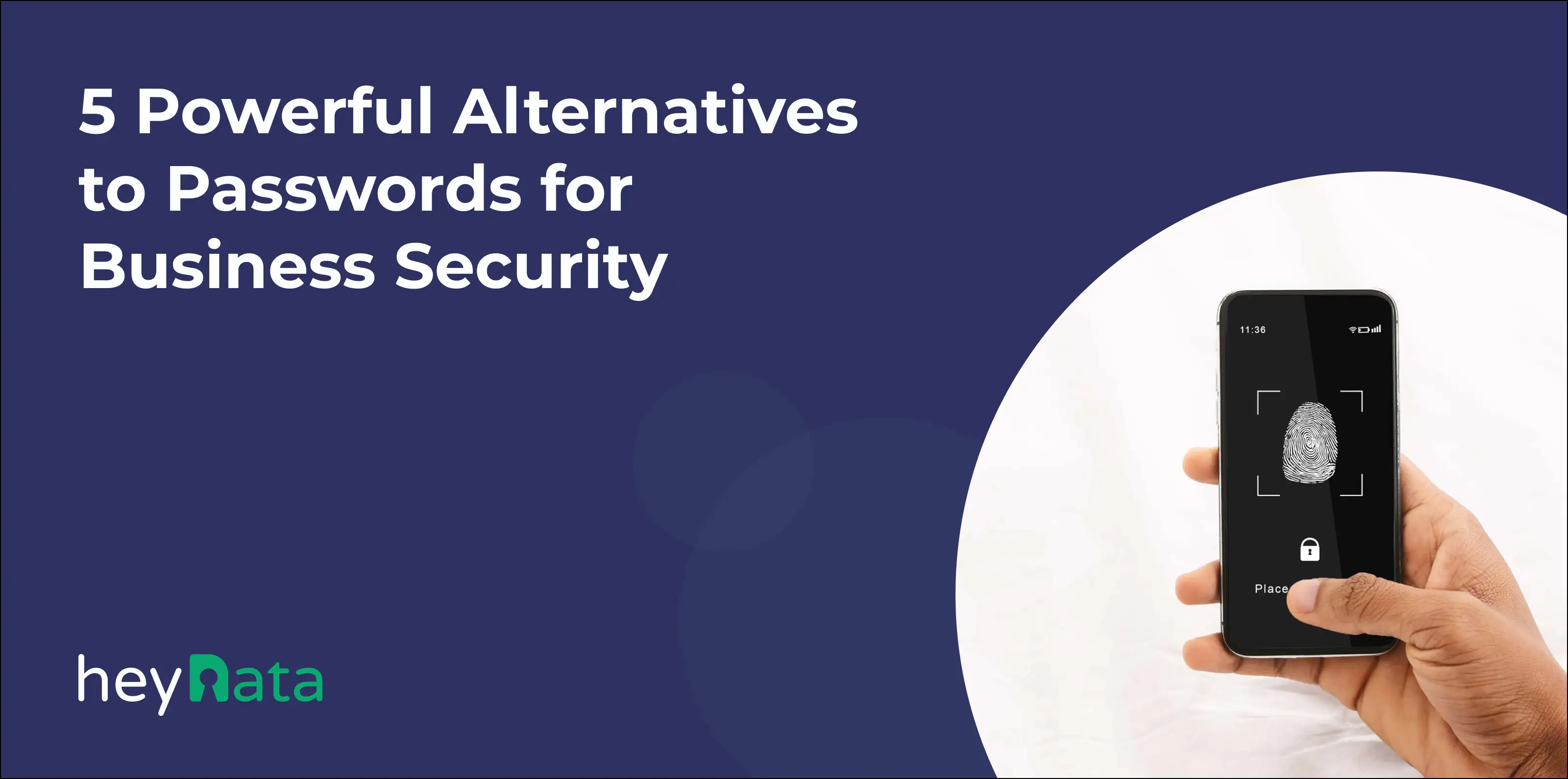
5 Powerful Alternatives to Passwords for Business Security

With a 30% increase in global cyber attacks in Q2 2024, improving cybersecurity is of vital importance to businesses of all sizes. And while traditional passwords aren't going away just yet despite the increasing security concerns associated with them, alternative authentication methods emerge providing an additional layer of security.
In this article, we will explore passwordless authentication methods that can improve security without relying on passwords, keeping your business safe in a more complicated digital world.
Table of Contents:
The Limitations of Password-Based Authentication
Although passwords have been a mainstay for many years, they come with limitations that render them progressively insufficient in the current cybersecurity environment. Credential theft can have a devastating effect on businesses of all sizes. Forrester estimates that over 80% of data breaches involve compromised credentials, highlighting the urgent need for more secure authentication methods.
These are the most common weaknesses of traditional passwords:
- Vulnerability to Password Attacks: Hackers can easily exploit weak or reused passwords through brute-force techniques or obtain them through data breaches.
- Human Error: Employees often choose easy-to-remember passwords, increasing the risk of unauthorized access. Additionally, forgetting passwords leads to lockouts, resets and frustration, resulting in productivity loss and increased costs.
- Data Leaks: Security breaches expose password databases, leading to credential theft and additional costs. According to Statista, the average cost of a data leak in Germany in 2023 was $16,000.
- Lack of Scalability: As businesses grow, managing password policies becomes complex and inefficient. Password resets and access management are time-consuming tasks that overload IT resources.
- Phishing and Social Engineering: Phishing involves cybercriminals deceiving users into disclosing their passwords via fake emails or websites. Social Engineering allows hackers to bypass the authentication process altogether by deceiving users into revealing their passwords.
Benefits of Passwordless Authentication
This is where passwordless authentication methods enter the picture. Passwordless Multi-Factor Authentication eliminates the reliance on passwords by utilizing two or more authentication methods. The shift towards passwordless authentication presents significant advantages for organizations, including:
- Enhanced Security: By eliminating passwords, the risk of credential theft is substantially reduced. Passwordless authentication minimizes vulnerabilities associated with phishing attacks and data breaches.
- Improved User Experience: Passwordless methods offer seamless login processes. Users can access systems quickly without the hassle of remembering complex passwords, leading to increased productivity.
- Cost-effectiveness: Managing user identities becomes simpler and more efficient. Businesses can reduce IT overhead related to password resets, account lockouts, and other password management issues.
Embracing these benefits enhances security measures while promoting a user-friendly environment.
5 Alternative Authentication Methods for Enhanced Security
1. Biometric Authentication
Biometric authentication uses unique physical characteristics to verify a person's identity. This technology analyzes traits like fingerprints, voice, facial features, or iris patterns and compares them against previously recorded biometric templates to gain access.
This authentication method is commonly used on smartphones, as most mobile devices now have biometric features for unlocking screens and authorizing transactions.
Organizations use biometric systems to restrict access to sensitive areas, ensuring that only authorized personnel can enter. Other companies, such as Barclays leverage voice recognition for client identification. During the opening seconds of a call with an agent, their biometrics solution checks a client's voice against their previously recorded voiceprint.
Strengths:
- High Level of Security: Biometric identifiers are unique, making them hard to replicate or steal.
- User-Friendly Experience: Quick login processes enhance user satisfaction by minimizing the steps needed to access accounts and services.
- Reduced Risk of Credential Theft: These identifiers are directly linked to the individual, reducing risks associated with password theft.
Weaknesses:
- Initial Setup Costs: Implementing biometric systems can require substantial investment in hardware and software.
- Data Privacy Concerns: Storing biometric data raises significant privacy issues, as breaches could lead to irreversible identity theft.
- Ethical Concerns: The use of biometric authentication raises several ethical questions. For example, the extent to which organizations should be allowed to collect and use biometric data as employees may feel pressured into providing their biometric information.
2. Hardware-Based Authentication Solutions
Hardware-based authentication methods utilize small, portable physical devices such as security keys or smart cards to verify a user's identity, providing an additional layer of security beyond traditional passwords. These methods often involve hardware tokens or security tokens that generate one-time codes or store cryptographic keys to provide secure access.
These are commonly used to access secure facilities or log into corporate networks.
Multinational organizations such as Google, Microsoft, and Amazon advocate and leverage hardware-based authentication.
Strengths:
- Strong Physical Security: Offers robust protection against remote attacks, making it difficult for unauthorized users to gain access, as an attacker would need to possess a physical device.
- User-Friendly Experience: Once set up correctly, these solutions are easy to use and require minimal user intervention.
- Compatibility: Most hardware tokens work across various platforms and services, enhancing flexibility in implementation.
Weaknesses:
- Risk of Loss or Damage: Physical tokens can be misplaced or broken, potentially locking users out of their accounts.
- Initial Investment: Purchasing hardware can incur significant upfront costs, especially for larger teams.
- User Inconvenience: If not properly stored or maintained, users may face difficulties in accessing their devices when needed.
3. Token-Based Authentication Solutions
Token-based authentication utilizes temporary tokens typically delivered via mobile push notifications or SMS to verify user identity. During the login process, users receive a token on their mobile device and input it into the authentication system.
Token-based authentications also include time-based one-time passwords (OTP). One-time passwords can be generated by authenticator apps, providing an additional layer of security as the tokens are time-sensitive.
This method is often used as a part of two-factor authentication as well as for online transactions.
Strengths:
- Enhanced Security: Tokens are inherently more secure than static usernames and passwords, significantly reducing the risk of credential theft.
- Flexibility: Implementation can be adapted across various devices and applications, making it suitable for diverse environments.
- Scalability: As businesses grow, token-based systems can easily scale to accommodate increasing numbers of users without compromising security.
Weaknesses:
- Device Reliance: Token-based authentication is commonly used in conjunction with mobile apps, which rely on the possession of the registered mobile device.
- Requires revalidation: Token-based authentication is not suited for long-term access, as all tokens eventually expire. As a result, administrators must manage token life cycles and renew credentials as necessary.
- Compromised Single Key: The major advantage of token-based authentication is its convenience, as it only requires a single key to access a system or, in the case of Single Sign-On authentication, multiple systems. This introduces a security risk as it can potentially lead to widespread data and application breaches. However, this weakness can be minimized by using token-based authentication in conjunction with other authentication methods.
4. Public Key Infrastructure (PKI) Solutions
Public Key Infrastructure (PKI) authentication verifies identity using a pair of cryptographic keys - a public key and a private key. Users possess a private key stored on their device, while the corresponding public key is stored on the authentication system. When a user attempts to authenticate, the system generates a challenge that can only be decrypted using the user's private key. If the challenge is successfully decrypted, the user is granted access.
This method is commonly used for email encryption, ensuring that only intended recipients can access sensitive information as well as for securing websites by facilitating HTTPS connections to protect user data during online transactions.
Strengths:
- High Security: PKI provides strong encryption and authentication, ensuring that sensitive data is securely transmitted and only accessible by authorized parties. This reduces the risk of data breaches, making it ideal for protecting critical business information.
- Scalability: PKI can handle large-scale environments, making it suitable for businesses of all sizes. It supports a broad range of use cases, from securing emails and websites to authenticating users and devices across an enterprise.
- Compliance with Regulations: Many industries, like finance and healthcare, require strict data security standards. PKI helps businesses meet regulatory requirements such as GDPR, HIPAA, or PCI-DSS by providing secure encryption and authentication methods.
Weaknesses:
- Complex Implementation: Setting up a PKI system can be technically challenging and resource-intensive. It requires careful planning, installation of infrastructure, and ongoing management, which can be daunting for businesses without dedicated IT resources.
- Cost: The initial setup, maintenance, and management of PKI can be expensive. Businesses need to invest in certificate authorities (CAs), hardware, software, and skilled personnel to manage the system, which may be prohibitive for smaller organizations.
- Key Management Challenges: Managing encryption keys and digital certificates can be complex. If private keys are lost, compromised, or not properly managed, it can lead to security vulnerabilities or disruptions in service, requiring significant oversight and control mechanisms.
5. Mobile Device Authentication Solutions
Mobile device authentication leverages the unique characteristics and capabilities of mobile devices to verify user identity. This method often relies on device-specific identifiers, such as IMEI numbers (device IDs), SIM card details, or hardware-based trusted certificates that are unique to each device. When a user attempts to authenticate, the system checks these unique identifiers to ensure that the request comes from a recognized and trusted device.
Mobile authentication may also use biometric sensors (like fingerprint or facial recognition) or encrypted communications, ensuring a higher level of security by binding the user’s identity to their specific mobile device.
Strengths:
- Convenience: Mobile devices are always with users, making authentication quick and easy. Biometric features (like fingerprint or facial scans) are fast and seamless, improving the user experience without compromising security.
- Integration: Seamlessly integrates with existing systems, making implementation easier.
- Cost-Effectiveness: Mobile authentication can reduce the need for physical tokens or smart cards, cutting costs associated with distributing and managing authentication devices.
Weaknesses:
- Device Dependency: Mobile device authentication is reliant on the availability of the user’s specific device. If the device is lost, stolen, or damaged, users may be unable to access business systems until recovery or alternative methods are set up, causing disruptions.
- Network Dependency: Performance relies on mobile network reliability, which can vary.
- Security Risks in Case of Compromise: If a mobile device is compromised through malware, SIM swapping, or other attacks, the authentication process could be vulnerable. Securing mobile devices requires strong mobile management policies, which adds complexity to business security protocols.
How to Choose the Right Authentication Method?
Selecting the appropriate method among passwordless solutions for SMBs requires careful consideration. Evaluate different authentication methods based on the security needs of your organization, the user experience provided by the solution, and the scalability necessary to ensure your authentication method can grow with your organization.
The importance lies in balancing security and user experience. A complex system may deter users, while a simple method may expose vulnerabilities.
To implement chosen solutions effectively, conduct a risk assessment to identify potential threats unique to your operations, collaborate with stakeholders within your organization to understand their needs and preferences, and conduct pilot testing by starting with a small group before rolling out organization-wide. If you need help with the implementation process, we are happy to offer our comprehensive data protection support.
Choosing the right method for your business enhances both security and usability, contributing to a reliable authentication strategy for your business.
Important: The content of this article is for informational purposes only and does not constitute legal advice. The information provided here is no substitute for personalized legal advice from a data protection officer or an attorney. We do not guarantee that the information provided is up to date, complete, or accurate. Any actions taken on the basis of the information contained in this article are at your own risk. We recommend that you always consult a data protection officer or an attorney with any legal questions or problems.


